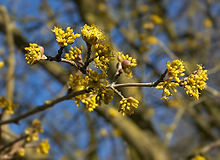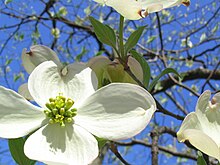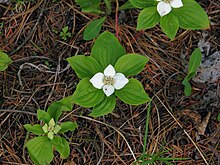Cornus
| Cornus kousa | |
|---|---|

| |
| Cornus kousa var. chinensis | |
| Scientific classification | |
| Kingdom: | |
| (unranked): | |
| (unranked): | |
| (unranked): | |
| Order: | |
| Family: | |
| Genus: | Cornus |
| Type species | |
| Cornus mas | |
| Subgenera | |
| |





The genus Cornus is a group of about 30-60 species[Note 1] of woody plants in the family Cornaceae, commonly known as dogwoods. Most dogwoods are deciduous trees or shrubs, but a few species are nearly herbaceous perennial subshrubs, and a few of the woody species are evergreen. Several species have small heads of inconspicuous flowers surrounded by an involucre of large, typically white petal-like bracts, while others have more open clusters of petal-bearing flowers. The various species of dogwood are native throughout much of temperate and boreal Eurasia and North America, with China and Japan and the southeastern United States particularly rich in native species.
The dogwoods include the common dogwood (Cornus sanguinea) of Eurasia, the widely cultivated flowering dogwood (Cornus florida) of eastern North America, the Pacific dogwood (Cornus nuttallii) of western North America, the Kousa Dogwood (Cornus kousa) of eastern Asia, and two low-growing boreal species, the Canadian and Eurasian dwarf cornels (or bunchberries), Cornus canadensis and Cornus suecica, respectively.
Depending on botanical interpretation, the dogwoods are variously divided into one to nine genera or subgenera; a broadly inclusive genus Cornus is accepted here, with four subgenera.
Common name "dogwood"
The name "dog-tree" entered the English vocabulary by 1548, and had been further transformed to "dogwood" by 1614. Once the name dogwood was affixed to this kind of tree, it soon acquired a secondary name as the Hound's Tree, while the fruits came to be known as dogberries or houndberries (the latter a name also for the berries of black nightshade, alluding to Hecate's hounds). Another theory advances the view that "dogwood" was derived from the Old English dagwood, from the use of the slender stems of its very hard wood for making "dags" (daggers, skewers, and arrows).[2][3] Another, earlier name of the dogwood in English is the whipple-tree. Geoffrey Chaucer uses "whippletree" in The Canterbury Tales ("The Knight's Tale", verse 2065) to refer to the dogwood. A whippletree is an element of the traction of a horse-drawn cart, linking the drawpole of the cart to the harnesses of the horses in file; these items still bear the name of the tree from which they are commonly carved.
Characteristics
Dogwoods have simple, untoothed leaves with the veins curving distinctively as they approach the leaf margins. Most dogwood species have opposite leaves, while a few, such as Cornus alternifolia and C. controversa, have their leaves alternate. Dogwood flowers have four parts. In many species, the flowers are borne separately in open (but often dense) clusters, while in various other species (such as the flowering dogwood), the flowers themselves are tightly clustered, lacking showy petals, but surrounded by four to six large, typically white petal-like bracts.
The fruits of all dogwood species are drupes with one or two seeds, often brightly colorful. The drupes of several species in the subgenera Cornus and Benthamidia are edible, though without much flavor. However, those of species in subgenus Swida are mildly toxic to people, though readily eaten by birds.
Dogwoods are used as food plants by the larvae of some species of butterflies and moths, including the Emperor moth, the Engrailed, the small angle shades, and the following case-bearers of the genus Coleophora: C. ahenella, C. salicivorella (recorded on Cornus canadensis), C. albiantennaella, C. cornella and C. cornivorella, with the latter three all feeding exclusively on Cornus.
Uses
Dogwoods are widely planted horticulturally, and the dense wood of the larger-stemmed species is valued for certain specialized purposes. Cutting Boards and other fine turnings can be made from this fine grained and beautiful wood.
Horticulture
Various species of Cornus, particularly the flowering dogwood (Cornus florida), are ubiquitous in American gardens and landscaping; horticulturist Donald Wyman stated "There is a dogwood for almost every part of the U.S. except the hottest and dryest areas".[4] However, in England, the lack of sharp winters and hot summers makes Cornus florida very shy of flowering.[5]
Many species in subgenus Swida are stoloniferous shrubs that grow naturally in wet habitats and along waterways. Several of these are used along highways and in naturalizing landscape plantings, especially those species with bright red or bright yellow stems, particularly conspicuous in winter, such as Cornus stolonifera.
Most of the species in subgenus Benthamidia, including the flowering dogwood, are small trees useful as ornamental plants. When flowering, they are of rare elegance and beauty, comparable to Carolina silverbell, Canadian serviceberry, and the Eastern redbud for their ornamental qualities.
Wood
Dense and fine-grained, dogwood timber has a density of .079 and is highly prized for making loom shuttles, tool handles and other small items that require a very hard and strong wood. Though it is tough for woodworking, some artisans favor dogwood for small projects such as walking canes, longbows, mountain dulcimers and fine inlays. Dogwood wood is an excellent substitute for persimmon wood in the heads of certain golf clubs (“woods”). Dogwood lumber is rare in the fact that it is not readily available with any manufacturer and must be cut down by the person(s) wanting to use it.
Larger items have also been occasionally made of dogwood, such as the screw-in basket-style wine or fruit presses. The first kinds of laminated tennis rackets were also made from this wood, cut into thin strips.
Dogwood twigs were used by pioneers to brush their teeth. They would peel off the bark, bite the twig and then scrub their teeth.[6]
Classification
Dogwoods are grossly distinguished by the relative conspicuousness of their flowers and bracts (involucres). The following classification recognizes a single, inclusive genus Cornus,[7][8] with four subgenera. Synonyms are given to provide equivalent names if these subgenera are recognized instead as the separate genera Benthamidia, Chamaepericlymenum, and Swida, in addition to a more narrowly taken Cornus, and also for a five-genus classification, in which Dendrobenthamidia is distinguished from a more narrowly taken Benthamidia. Note that the four species in the subgenus Cornus below retain the same names regardless of whether these additional genera are separately recognized. In a few cases, when a species listed here is sometimes separated instead into two species, that additional name is also listed, with the notation "here including ...".
Geographical ranges as native plants are given below. In addition, cultivated species occasionally persist or spread from plantings beyond their native ranges, but are rarely if ever locally invasive.[Note 2]
Bracts showy but flowers inconspicuous
Flower clusters inconspicuous, usually greenish, but surrounded by large, showy petal-like bracts; fruit usually red:
- Subgenus Benthamidia (syn. subgenus Dendrobenthamia, subgenus Cynoxylon). Flowering dogwoods; five species of trees, divisible into two subgroups (Benthamidia, with individual drupes, and Dendrobenthamia, with the drupes coalesced into a compound fruit[9]).
- Cornus capitata (Benthamidia capitata, Dendrobenthamia capitata; Himalayan Flowering Dogwood). Himalaya.
- Cornus florida (Benthamidia florida; Flowering Dogwood). U.S. east of the Great Plains, north to southern Ontario.
- Cornus hongkongensis (Benthamidia hongkongensis, Dendrobenthamia hongkongensis; Hongkong Dogwood). Southern China, Laos, Vietnam.
- Cornus kousa (Benthamidia kousa, Dendrobenthamia kousa; Kousa Dogwood). Japan and (as subsp. chinensis) central and northern China.
- Cornus nuttallii (Benthamidia nuttallii; Pacific Dogwood). Western North America, from British Columbia to California.
- Cornus × rutgersensis (Hybrid: C. florida × C. kousa). Horticulturally developed.[10][11]
- Subgenus Chamaepericlymenum. Bunchberries or Dwarf cornels; two species of creeping subshrubs growing from woody stolons.
- Cornus canadensis (Chamaepericlymenum canadense; Canadian Dwarf Cornel or Bunchberry) Northern North America, southward in the Appalachian and Rocky Mountains.
- Cornus suecica (Chamaepericlymenum suecicum; Eurasian Dwarf Cornel or Bunchberry). Northern Eurasia, locally in extreme northeast and northwest North America.
- Cornus × unalaschkensis (Hybrid: C. canadensis × C. suecica). Aleutian Islands (Alaska), Greenland, and Labrador and Newfoundland in Canada.
Flowers semi-showy, lacking large bracts
Flower clusters (cymes) semi-showy, usually white or yellow, with surrounding bracts (involucre) either small and deciduous, or lacking altogether; fruit red, blue, or white:
- Subgenus Cornus. Cornels; four species of shrubs or small trees; flower clusters with deciduous bracts (involucre).
- Cornus chinensis (Chinese Cornel). China.
- Cornus mas (European Cornel or Cornelian-cherry). Mediterranean.
- Cornus officinalis (Japanese Cornel). China, Japan, Korea.
- Cornus sessilis (Blackfruit Cornel). California.
- Subgenus Swida. Dogwoods; about 20-30 species of shrubs; flower clusters without an involucre.
- Cornus alba[Note 3] (Swida alba; Siberian Dogwood). Siberia and northern China.
- Cornus alternifolia (Swida alternifolia; Pagoda Dogwood or Alternate-leaf Dogwood). Eastern U.S. and southeastern Canada.
- Cornus amomum[Note 4] (Swida amomum; Silky Dogwood). Eastern U.S. east of the Great Plains except for the Deep South.
- Cornus asperifolia (Swida asperifolia; Toughleaf Dogwood). Southeastern U.S.
- Cornus austrosinensis (Swida austrosinensis; South China Dogwood). East Asia.
- Cornus bretschneideri (Swida bretschneideri; Bretschneider's Dogwood). Northern China.
- Cornus controversa (Swida controversa; Table Dogwood). East Asia.
- Cornus coreana (Swida coreana; Korean Dogwood). Northeast Asia.
- Cornus drummondii (Here including C. priceae; Swida drummondii; Roughleaf Dogwood). U.S. between the Appalachia and the Great Plains, and southern Ontario, Canada.
- Cornus foemina (Here including C. stricta; Swida foemina; Stiff Dogwood) Southeastern and southern United States.
- Cornus glabrata (Swida glabrata; Brown Dogwood or Smooth Dogwood). Western North America.
- Cornus hemsleyi (Swida hemsleyi; Hemsley's Dogwood). Southwest China.
- Cornus koehneana (Swida koehneana; Koehne's Dogwood). Southwest China.
- Cornus macrophylla (Swida macrophylla; Large-leafed Dogwood). East Asia.
- Cornus obliqua[Note 5] (Swida obliqua; Pale Dogwood). Northeastern and central U.S., and southeastern Canada.
- Cornus paucinervis (Swida paucinervis). China.
- Cornus racemosa (Swida racemosa; Northern Swamp Dogwood or Gray Dogwood). Northeastern and central U.S., and extreme southeastern Canada.
- Cornus rugosa (Swida rugosa; Round-leaf Dogwood). Northeastern and north-central U.S., and southeastern Canada.
- Cornus sanguinea (Swida sanguinea; Common Dogwood). Europe.
- Cornus sericea[Note 6] (Here including C. stolonifera; Swida sericea; Red Osier Dogwood).Northern and western North America, except Arctic regions.
- Cornus stricta[Note 7] (Swida stricta; Southern Swamp Dogwood). Southeastern U.S.
- Cornus walteri (Swida walteri; Walter's Dogwood). Central China.
- Cornus wilsoniana (Swida wilsoniana; Wilson's Dogwood). Central China.
Cultural references
The inflorescence ("flower") of the Pacific dogwood (Cornus nuttallii) is the official flower of the province of British Columbia. The flowering dogwood (Cornus florida) and its inflorescence are the state tree and the state flower respectively for the U.S. Commonwealth of Virginia. It is also the state tree of Missouri and the state flower of North Carolina.
The poet Vergil makes reference to a haunted copse of cornel and myrtle in Book III of the Aeneid. The hero Aneas attempts to break off boughs to decorate an altar, but instead the wood drips with black blood.[12]
Many Christians consider the flowering dogwood's showy cross-like inflorescences ("flowers") to be religious symbols, due to their four white petal-like bracts bearing red dots on their tips; these trees are often in flower during the springtime Easter season in the Northern Hemisphere. Christian tradition claims the dogwood as the tree used to make the cross on which Jesus was crucified, and further, that dogwoods grew taller and broader until the 1st Century AD, making them suitable for use as crosses. In response to Jesus's death on one, God permanently stunted the growth of the dogwood species to prevent them ever again being used for the same purpose. Today, very few dogwood specimens would provide sufficient wood to manufacture a cross by the primitive means of the 1st Century AD.[citation needed]
In the Victorian Era, flowers or sprigs of dogwoods were presented to unmarried women by male suitors to signify affection. The returning of the flower conveyed indifference on the part of the woman; however, if she kept it, it became a sign of mutual interest.[citation needed]
The term "dogwood winter", in colloquial use in the American Southeast, is sometimes used to describe a cold snap in spring, presumably because farmers believed it was not safe to plant their crops until after the dogwoods blossomed.[13]
Notes
- ^ 58 species according to Xiang et al. (2006)[1]
- ^ For further detail on distributions of native North American dogwoods, see Cornus in BONAP's North American Plant Atlas.
- ^ Cornus sericea, treated separately here, is sometimes included in a more broadly taken concept of Cornus alba, which in that sense is also native in North America.
- ^ Cornus obliqua, here recognized separately, has been included in a broader concept of C. amomum by some botanists. Canadian reports for C. amomum are apparently all based on plants here classified as C. obliqua.
- ^ Cornus obliqua is sometimes included in a more broadly taken concept of C. amomum, also in the eastern U.S.
- ^ Cornus sericea (including C. stolonifera) is sometimes itself included in a more broadly taken concept of the otherwise Eurasian Cornus alba.
- ^ Cornus stricta is sometimes included in a more broadly taken concept of C. foemina, also in the eastern U.S.
References
- ^ Qiu-Yun (Jenny) Xiang, David T. Thomas, Wenheng Zhang, Steven R. Manchester and Zack Murrell (2006). "Species level phylogeny of the genus Cornus (Cornaceae) based on molecular and morphological evidence – implications for taxonomy and Tertiary intercontinental migration". Taxon. 55 (1): 9–30. JSTOR 25065525.
{{cite journal}}: CS1 maint: multiple names: authors list (link) - ^ Vedel, H., & Lange, J. (1960). Trees and Bushes in Wood and Hedgerow. Metheun & Co. Ltd., London.
- ^ Fernald, Merritt Lyndon (1950). Gray's Manual of Botany (8th ed.). New York: American Book Company.
- ^ Wyman's Garden Encyclopedia, s.v. "Cornus"
- ^ Alice M. Coats, Garden Shrubs and their Histories (1964) 1992, s.v. "Cornus".
- ^ Gunn, John C. (1835). Gunn's Domestic Medicine (4th ed.). p. 523.
- ^ Richard H. Eyde (1987). "The case for keeping Cornus in the broad Linnaean sense". Systematic Botany. 12 (4): 505–518. JSTOR 2418886.
- ^ Richard H. Eyde (1988). "Comprehending Cornus: puzzles and progress in the systematics of the dogwoods". Botanical Review. 54 (3): 233–351. JSTOR 4354115.
- ^ Rushforth, K. (1999). Trees of Britain and Europe. Collins ISBN 0-00-220013-9.
- ^ "Cornus florida × Cornus kousa". Landscape Plants: Images, identification, and information. Oregon State University. Retrieved 20 May 2011.
- ^ "Cornus × rutgersensis 'Aurora'". Dave's Garden. Retrieved 20 May 2011.
- ^ Aeneid III 22-23: Forte fuit iuxta tumulus, quo cornea summo virgulta et densis hastilibus horrida myrtus.
- ^ http://www.farmersalmanac.com/weather/2011/04/25/what-is-dogwood-winter/
